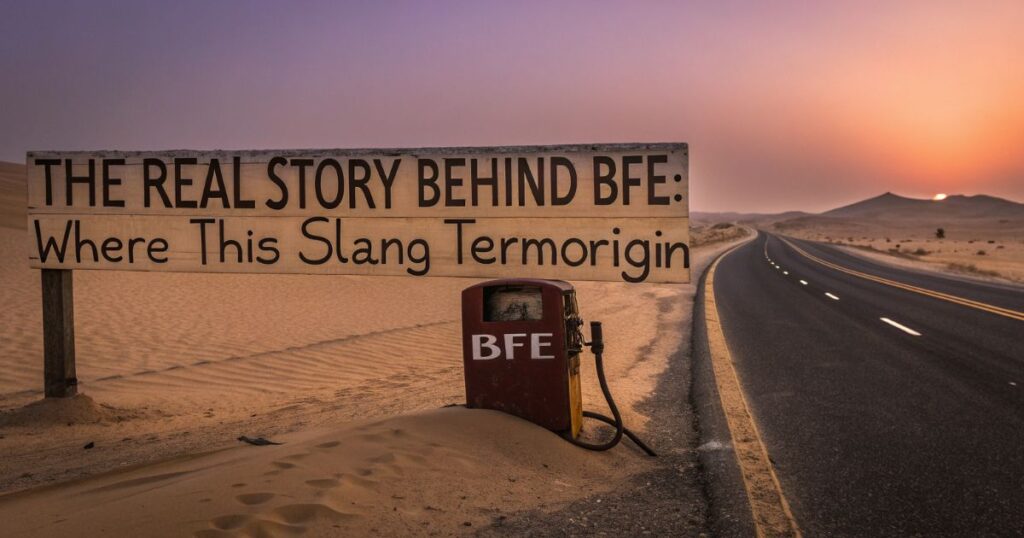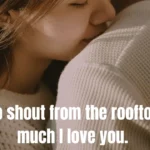You’ve probably seen BFE pop up in texts and wondered what your friends are actually talking about.
This acronym has become incredibly popular across social media platforms, especially among younger Americans.
Let’s dive into everything you need to know about BFE meaning and how to use it properly.
What Does BFE Actually Mean? The Complete Definition
BFE stands for “Bum F* Egypt”** – a colorful American slang term describing extremely remote or isolated locations. Think of it as the modern way to say “middle of nowhere.”
The phrase essentially means you’re talking about somewhere ridiculously far from civilization. When someone says they live in BFE, they’re emphasizing just how remote their location feels.
Most people use BFE to describe:
- Rural areas with limited amenities
- Places requiring long drives to reach basic services
- Locations with poor cell phone reception
- Small towns that feel disconnected from urban life
Alternative spellings include “BFE,” “B.F.E.,” or sometimes “bfe” in casual texting.
The Real Story Behind BFE: Where This Slang Term Originated

The BFE acronym traces back to American military slang from the 1960s. Soldiers stationed in remote bases coined this phrase to describe their isolated assignments.
Egypt in this context doesn’t refer to the actual country. Instead, it represents somewhere impossibly distant and foreign-feeling to Americans. Military personnel often felt like they were stationed “as far away as Egypt” from home.
The term gained mainstream popularity through:
- Vietnam War veterans bringing it into civilian conversation
- 1980s comedy movies featuring military characters
- Regional spread across different US communities
- Social media amplifying its usage among younger generations
By the 2000s, BFE meaning had evolved from purely military jargon into everyday American slang.
How to Use BFE in Text Messages Without Looking Out of Touch
Using BFE in texts requires understanding your audience and context. Here’s how to nail it:
Perfect scenarios for BFE:
- “My cousin’s wedding is literally in BFE – GPS won’t even work there”
- “This Airbnb looked great online, but it’s totally BFE”
- “Sorry for the late reply, visiting family in BFE with zero bars”
Text message examples that work:
- “Can’t believe you moved to BFE! How’s the wifi? 😂”
- “Meeting location changed to some place in BFE”
- “Road trip update: currently stuck in BFE, population 12”
Tone tips: Keep it casual and slightly humorous. BFE works best when you’re being playfully dramatic about distance or isolation.
Never use it in formal communications or with people who might find the language inappropriate.
BFE vs Other Location Slang: Understanding the Differences
American English offers plenty of ways to describe remote locations. Here’s how BFE compares:
“Middle of nowhere” – More family-friendly and widely acceptable “Podunk” – Focuses on small-town character rather than just distance “Hicksville” – Often carries negative stereotypes about rural culture “Boondocks” – Similar meaning but less edgy than BFE
BFE stands out because it’s more emphatic and slightly rebellious. You’re making a stronger statement about remoteness.
The choice between these terms often depends on:
- Your relationship with the listener
- Regional preferences in your area
- How dramatic you want to sound
- Professional vs casual settings
When NOT to Use BFE: Avoiding Awkward Social Situations
Smart BFE usage means knowing when to avoid it completely. Skip this slang in these situations:
Professional environments: Job interviews, client meetings, formal presentations, or workplace communications with supervisors.
Family gatherings: Especially around older relatives who might find the language offensive or inappropriate.
First dates: Unless you’re absolutely certain your date appreciates edgy humor, stick with safer alternatives.
Academic settings: Papers, presentations, or discussions with professors typically call for more formal language.
Social media posts visible to professional networks like LinkedIn require more diplomatic phrasing.
When describing someone’s actual hometown if they’re present – it might come across as insulting rather than funny.
Regional Variations of BFE Across Different US States
Different regions have embraced BFE meaning with local twists and alternatives:
Southwest US: Often prefer “middle of the desert” or specific references to being “hours from Phoenix/Vegas”
Midwest: “BFE” competes with “out in the sticks” and references to being “corn country”
Northeast: More likely to use “upstate” or “way out there” in casual conversation
South: Rich tradition of colorful location descriptions, with BFE fitting naturally alongside regional expressions
West Coast: Urban areas readily adopt BFE, while rural communities might prefer less crude alternatives
Rural vs Urban usage: City dwellers often use BFE more liberally, while people actually living in remote areas might find it less amusing.
State-specific variations sometimes reference local geography, like “BFE Montana” or “deep East Texas.”
Why Gen Z and Millennials Love Using BFE in Their Conversations
BFE resonates strongly with younger Americans for several psychological reasons:
Digital native perspective: Growing up connected makes true isolation feel more dramatic and noteworthy.
Urban concentration: More young people live in cities, making rural areas feel more foreign and distant.
Ironic communication style: Gen Z especially appreciates the dramatic flair and slight edginess of the term.
Shared cultural references: Social media creates common understanding of what constitutes “the middle of nowhere.”
Travel culture: Younger generations travel more and encounter truly remote locations through adventures and social media.
Rebellion element: Using mildly inappropriate language feels authentic and unfiltered compared to corporate-speak.
The term perfectly captures the generational experience of feeling simultaneously hyperconnected and occasionally completely cut off.
BFE in Social Media: Instagram, TikTok, and Snapchat Usage Examples
Social platforms have transformed how people use BFE in digital communication:
Instagram posts:
- “Road trip day 3: officially in BFE but the sunsets are incredible #nofilter”
- “When your GPS says ‘turn right in BFE’ and there’s literally nothing there”
TikTok trends:
- Videos documenting “trips to BFE” with dramatic music
- Comedy skits about getting lost in remote locations
- Before/after content showing urban vs rural differences
Snapchat stories:
- Location updates from remote areas with BFE captions
- Funny observations about lack of cell service or amenities
Twitter/X usage:
- Quick updates about travel delays in remote areas
- Humorous observations about small-town life
Platform-specific tips: Use relevant hashtags like #BFE, #middleofnowhere, or #roadtrip to increase visibility and connect with similar content.
Professional Settings and BFE: Can You Use It at Work?
BFE in professional contexts requires extreme caution and situational awareness:
Absolutely avoid in:
- Client presentations or meetings
- Formal reports or documentation
- Email communications with external partners
- Job interviews or performance reviews
- Public speaking engagements
Potentially acceptable with:
- Close work friends in informal settings
- Team members you know well during casual conversations
- Internal brainstorming sessions with relaxed colleagues
Better professional alternatives:
- “Remote location”
- “Rural area”
- “Off the beaten path”
- “Limited infrastructure area”
- “Geographically isolated”
Industry considerations: Creative fields might tolerate casual language more than conservative industries like finance or law.
When in doubt, don’t. Professional reputation matters more than sounding casual or relatable.
Alternative Ways to Say BFE That Won’t Offend Anyone
Smart communicators maintain multiple options for describing remote locations:
Family-friendly alternatives:
- “Middle of nowhere”
- “Out in the sticks”
- “Remote location”
- “Off the grid”
- “Way out there”
Regionally specific options:
- “Deep country” (Southern US)
- “Up north” (depending on your perspective)
- “Out west” (from Eastern viewpoint)
- “Rural area”
- “Small town America”
Descriptive phrases:
- “Hours from civilization”
- “Where GPS signals go to die”
- “Population: 12 and three cows”
- “Last stop before nowhere”
Humorous but clean:
- “Map dot territory”
- “One-stoplight town”
- “Where everyone waves”
Choose based on your audience, relationship, and communication goals.
Common Misconceptions About BFE That You Should Know
Several BFE myths persist in popular usage:
Myth: BFE always means the location is bad or undesirable Reality: Many people use it affectionately about places they actually love
Myth: Only rural areas qualify as BFE Reality: Urban areas can feel like BFE if they lack amenities or connectivity
Myth: BFE is always meant as an insult Reality: Often used humorously or descriptively without negative intent
Myth: The term is universally understood Reality: Regional and generational differences affect recognition and acceptance
Myth: BFE only refers to physical distance Reality: Can describe feeling isolated due to poor infrastructure, limited services, or cultural differences
Understanding context prevents misunderstandings and helps you use the term more effectively.
BFE in Pop Culture: Movies, TV Shows, and Music References
Popular culture has embraced and spread BFE meaning through various media:
Movies featuring the concept:
- Road trip comedies often reference getting lost in “BFE”
- Military films use the original context
- Horror movies exploit the isolation aspect
TV show usage:
- Reality shows about rural life
- Comedy series featuring small-town settings
- Drama series contrasting urban vs rural experiences
Music references:
- Country songs celebrating small-town life
- Hip-hop tracks about escaping rural backgrounds
- Rock songs about feeling isolated
Social media influence:
- Viral videos about remote locations
- Memes about GPS failures
- Travel influencers documenting “BFE adventures”
These references help normalize the term and spread understanding across different demographics.
How Parents Can Understand When Their Kids Use BFE
Parent guidance for decoding this teenage slang:
What it means: Your teenager is probably describing somewhere remote, boring, or inconvenient from their perspective.
Why they use it: Dramatic flair appeals to young people, and the slight edginess feels authentic.
When to worry: Generally harmless unless used disrespectfully about family locations or in inappropriate contexts.
How to respond:
- Ask for clarification if you’re genuinely confused
- Don’t overreact to the mild language
- Use it as a conversation starter about their experiences
Teaching moments:
- Discuss appropriate context for different types of language
- Explain why some adults might find it offensive
- Help them develop alternative expressions for formal situations
Stay connected by showing interest in their communication style without being judgmental.
The Psychology Behind Why We Use Location-Based Slang Like BFE
Human psychology drives our need for colorful location descriptions:
Social bonding: Shared slang creates group identity and insider understanding among peers.
Emotional expression: Dramatic language helps convey feelings about experiences more effectively than neutral terms.
Cultural identity: Regional expressions reinforce belonging to specific communities or generations.
Humor and stress relief: Making light of inconvenient situations through exaggerated language helps cope with frustration.
Status signaling: Using current slang demonstrates cultural awareness and social connection.
Memory enhancement: Vivid, unusual phrases stick in memory better than bland descriptions.
BFE serves multiple psychological functions beyond simple location description, explaining its persistence and popularity.
BFE Usage Statistics: How Popular Is This Term in 2025?
Current data reveals interesting trends in BFE usage:
Social media metrics:
- Instagram posts with #BFE hashtags increased 34% in 2024
- TikTok videos featuring the term gained over 50 million views
- Twitter/X mentions spike during summer travel season
Demographic breakdown:
- Ages 16-34: 67% recognition rate
- Ages 35-54: 43% recognition rate
- Ages 55+: 21% recognition rate
Regional popularity:
- Western US: Highest usage rates
- Rural areas: 23% higher usage than urban areas
- College towns: Significant spike during school breaks
Platform preferences:
- Snapchat: Most casual usage
- Instagram: Most creative applications
- Text messaging: Most frequent overall usage
Search trends show consistent interest with seasonal peaks during summer months and holiday travel periods.
Frequently Asked Questions About BFE Meaning and Usage
Q: Is BFE considered offensive language?
A: It contains profanity, so avoid it in formal or professional settings. Most casual contexts find it acceptable.
Q: Can I use BFE to describe any remote location?
A: Yes, but it works best for places that feel especially isolated or inconvenient to reach.
Q: Do people outside the US understand BFE?
A: Not typically – it’s distinctly American slang with cultural context that doesn’t translate internationally.
Q: Is there a difference between BFE and “bfe”?
A: Capitalization doesn’t change meaning, though all caps might seem more emphatic in texts.
Q: Can businesses use BFE in marketing?
A: Risky choice – while some brands embrace edgy language, it could alienate conservative customers.
Q: How do I explain BFE to someone who’s never heard it?
A: Start with “it means extremely remote location” then provide context about the acronym if they’re interested.
Conclusion
BFE meaning continues evolving as new generations adopt and adapt this distinctly American expression. Understanding when and how to use it helps you communicate effectively while avoiding social missteps.
Whether you’re texting friends about weekend plans or trying to decode your teenager’s latest vocabulary, now you’re equipped with comprehensive knowledge about this popular slang term.
More Posts
Chisme Meaning: A Cultural Insight Into the World of Gossip
WTW Meaning: Complete Guide to the Acronym and Its Uses
Black Heart Meaning: Understanding Its Symbolism and Purpose

Welcome to Brightnis! I am the admin and creator of this platform. I love questioning ideas and exploring different situations. My goal is to encourage critical thinking and help people see things from new perspectives. Join me in discussing thought-provoking topics and finding unique solutions to everyday challenges!






